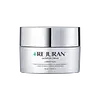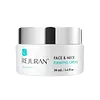What's inside
What's inside
 Key Ingredients
Key Ingredients

 Benefits
Benefits

 Concerns
Concerns

 Ingredients Side-by-side
Ingredients Side-by-side

Water
Skin ConditioningGlycerin
HumectantCaprylic/Capric Triglyceride
MaskingIsopropyl Palmitate
EmollientCyclopentasiloxane
EmollientButylene Glycol
HumectantPetrolatum
EmollientGlyceryl Stearate
EmollientCetyl Alcohol
EmollientButyrospermum Parkii Butter
Skin ConditioningGlyceryl Polyacrylate
1,2-Hexanediol
Skin ConditioningPvp
Emulsion StabilisingDimethicone
EmollientAlcohol Denat.
AntimicrobialBisabolol
MaskingCetearyl Alcohol
EmollientCeteareth-20
CleansingPEG-100 Stearate
Stearic Acid
CleansingPanthenol
Skin ConditioningSodium Hyaluronate
HumectantTocopheryl Acetate
AntioxidantIsopropyl Titanium Triisostearate
EmollientBis-PEG-15 Dimethicone/Ipdi Copolymer
PEG-2 Soyamine
EmulsifyingHydrolyzed Dna
Skin ConditioningAcrylates/C10-30 Alkyl Acrylate Crosspolymer
Emulsion StabilisingRetinyl Palmitate
Skin ConditioningSimmondsia Chinensis Seed Oil
EmollientSqualane
EmollientArgania Spinosa Kernel Oil
EmollientAloe Barbadensis Leaf Juice
Skin ConditioningGlycyrrhiza Glabra Root Extract
BleachingLavandula Angustifolia Flower/Leaf/Stem Oil
HumectantCitrus Aurantium Bergamia Peel Oil
Xanthan Gum
EmulsifyingSodium Hydroxide
BufferingLinalool
PerfumingLimonene
PerfumingEthylhexylglycerin
Skin ConditioningCitrus Paradisi Peel Oil
MaskingAdenosine
Skin ConditioningWater, Glycerin, Caprylic/Capric Triglyceride, Isopropyl Palmitate, Cyclopentasiloxane, Butylene Glycol, Petrolatum, Glyceryl Stearate, Cetyl Alcohol, Butyrospermum Parkii Butter, Glyceryl Polyacrylate, 1,2-Hexanediol, Pvp, Dimethicone, Alcohol Denat., Bisabolol, Cetearyl Alcohol, Ceteareth-20, PEG-100 Stearate, Stearic Acid, Panthenol, Sodium Hyaluronate, Tocopheryl Acetate, Isopropyl Titanium Triisostearate, Bis-PEG-15 Dimethicone/Ipdi Copolymer, PEG-2 Soyamine, Hydrolyzed Dna, Acrylates/C10-30 Alkyl Acrylate Crosspolymer, Retinyl Palmitate, Simmondsia Chinensis Seed Oil, Squalane, Argania Spinosa Kernel Oil, Aloe Barbadensis Leaf Juice, Glycyrrhiza Glabra Root Extract, Lavandula Angustifolia Flower/Leaf/Stem Oil, Citrus Aurantium Bergamia Peel Oil, Xanthan Gum, Sodium Hydroxide, Linalool, Limonene, Ethylhexylglycerin, Citrus Paradisi Peel Oil, Adenosine
Water
Skin ConditioningCamellia Sinensis Leaf Extract
AntimicrobialRubus Fruticosus Leaf Extract
MaskingChamomilla Recutita Flower Extract
MaskingNeopentyl Glycol Diethylhexanoate
EmollientEchinacea Angustifolia Meristem Cell Culture
Skin ConditioningSodium Hyaluronate
HumectantCyclopentasiloxane
EmollientGlycol Distearate
EmollientStearic Acid
CleansingCetearyl Alcohol
EmollientPalmitoyl Tripeptide-4
Skin ConditioningPalmitoyl Tripeptide-5
Skin ConditioningTrifluoroacetyl Tripeptide-2
Skin ConditioningCetyl Alcohol
EmollientButyrospermum Parkii Butter
Skin ConditioningIsostearyl Isostearate
EmollientCetyl Stearate
EmollientTocopherol
AntioxidantHydrolyzed Dna
Skin ConditioningAllantoin
Skin ConditioningPanthenol
Skin ConditioningCaprylic/Capric Triglyceride
MaskingAcrylates/C10-30 Alkyl Acrylate Crosspolymer
Emulsion Stabilising1,2-Hexanediol
Skin ConditioningEthylhexylglycerin
Skin ConditioningWater, Camellia Sinensis Leaf Extract, Rubus Fruticosus Leaf Extract, Chamomilla Recutita Flower Extract, Neopentyl Glycol Diethylhexanoate, Echinacea Angustifolia Meristem Cell Culture, Sodium Hyaluronate, Cyclopentasiloxane, Glycol Distearate, Stearic Acid, Cetearyl Alcohol, Palmitoyl Tripeptide-4, Palmitoyl Tripeptide-5, Trifluoroacetyl Tripeptide-2, Cetyl Alcohol, Butyrospermum Parkii Butter, Isostearyl Isostearate, Cetyl Stearate, Tocopherol, Hydrolyzed Dna, Allantoin, Panthenol, Caprylic/Capric Triglyceride, Acrylates/C10-30 Alkyl Acrylate Crosspolymer, 1,2-Hexanediol, Ethylhexylglycerin
 Reviews
Reviews

Ingredients Explained
These ingredients are found in both products.
Ingredients higher up in an ingredient list are typically present in a larger amount.
1,2-Hexanediol is a synthetic liquid and another multi-functional powerhouse.
It is a:
- Humectant, drawing moisture into the skin
- Emollient, helping to soften skin
- Solvent, dispersing and stabilizing formulas
- Preservative booster, enhancing the antimicrobial activity of other preservatives
Acrylates/C10-30 Alkyl Acrylate Crosspolymer is a synthetic polymer. It is used to thicken and improve the texture of products. Due to its properties, it can prevent water and oil ingredients from separating.
This ingredient is also known as shea butter. It is an effective skin hydrator and emollient.
Emollients help soothe and soften your skin. It does this by creating a protective film on your skin. This barrier helps trap moisture and keeps your skin hydrated. Emollients may be effective at treating dry or itchy skin.
Shea butter is rich in antioxidants. Antioxidants help fight free-radicals, or molecules that may harm the body. It is also full of fatty acids including stearic acid and linoleic acid. These acids help replenish the skin and keep skin moisturized.
While Shea Butter has an SPF rating of about 3-4, it is not a sunscreen replacement.
Shea butter may not be fungal acne safe. We recommend speaking with a professional if you have any concerns.
Learn more about Butyrospermum Parkii ButterThis ingredient is an emollient, solvent, and texture enhancer. It is considered a skin-softener by helping the skin prevent moisture loss.
It helps thicken a product's formula and makes it easier to spread by dissolving clumping compounds.
Caprylic Triglyceride is made by combining glycerin with coconut oil, forming a clear liquid.
While there is an assumption Caprylic Triglyceride can clog pores due to it being derived from coconut oil, there is no research supporting this.
Learn more about Caprylic/Capric TriglycerideCetearyl alcohol is a mixture of two fatty alcohols: cetyl alcohol and stearyl alcohol. It is mainly used as an emulsifier. Emulsifiers help prevent the separation of oils and products. Due to its composition, it can also be used to thicken a product or help create foam.
Cetearyl alcohol is an emollient. Emollients help soothe and hydrate the skin by trapping moisture.
Studies show Cetearyl alcohol is non-toxic and non-irritating. The FDA allows products labeled "alcohol-free" to have fatty alcohols.
This ingredient is usually derived from plant oils such as palm, vegetable, or coconut oils. There is debate on whether this ingredient will cause acne.
Due to the fatty acid base, this ingredient may not be Malassezia folliculitis safe.
Learn more about Cetearyl AlcoholCetyl Alcohol is a fatty alcohol. Fatty Alcohols are most often used as an emollient or to thicken a product.
Its main roles are:
Though it has "alcohol" in the name, it is not related to denatured alcohol or ethyl alcohol.
The FDA allows products labeled "alcohol-free" to have fatty alcohols.
Learn more about Cetyl AlcoholCyclopentasiloxane, or D5, is a silicone used to improve texture of products and trap moisture.
D5 is considered lightweight and volatile. Volatile means it evaporates quickly after application. Once evaporated, D5 leaves a thin barrier that helps keep skin hydrated.
It is also an emollient. Emollients help soften the skin and prevent water loss. Silicones create a silky texture in products. D5 helps other ingredients become more spreadable.
Studies show D5 is safe to use in skincare products. We recommend speaking with a skincare professional if you have concerns.
Learn more about CyclopentasiloxaneEthylhexylglycerin (we can't pronounce this either) is commonly used as a preservative and skin softener. It is derived from glyceryl.
You might see Ethylhexylglycerin often paired with other preservatives such as phenoxyethanol. Ethylhexylglycerin has been found to increase the effectiveness of these other preservatives.
We don't have a description for Hydrolyzed Dna yet.
Panthenol is a common ingredient that helps hydrate and soothe the skin. It is found naturally in our skin and hair.
There are two forms of panthenol: D and L.
D-panthenol is also known as dexpanthenol. Most cosmetics use dexpanthenol or a mixture of D and L-panthenol.
Panthenol is famous due to its ability to go deeper into the skin's layers. Using this ingredient has numerous pros (and no cons):
Like hyaluronic acid, panthenol is a humectant. Humectants are able to bind and hold large amounts of water to keep skin hydrated.
This ingredient works well for wound healing. It works by increasing tissue in the wound and helps close open wounds.
Once oxidized, panthenol converts to pantothenic acid. Panthothenic acid is found in all living cells.
This ingredient is also referred to as pro-vitamin B5.
Learn more about PanthenolSodium Hyaluronate is hyaluronic acid's salt form. It is commonly derived from the sodium salt of hyaluronic acid.
Like hyaluronic acid, it is great at holding water and acts as a humectant. This makes it a great skin hydrating ingredient.
Sodium Hyaluronate is naturally occurring in our bodies and is mostly found in eye fluid and joints.
These are some other common types of Hyaluronic Acid:
Learn more about Sodium HyaluronateStearic Acid is a fatty acid. It is an emollient, emulsifier, and texture enhancer.
As an emollient, stearic acid helps soften skin. It aids the skin's protective barrier by preventing water loss. It also provides a gentle cleansing effect without stripping away natural oils.
Stearic acid may also be used to enhance the texture of products. It can add volume and stabilize ingredients such as water and oil. This can help water and oil ingredients from separating.
Sources of stearic acid include animal or vegetable fats/oils such as coconut or shea. It can be naturally found in butter, cocoa butter, shea butter, vegetable fats, and animal tallow.
This ingredient may not be Malassezia folliculitis, or fungal-acne safe.
Learn more about Stearic AcidWater. It's the most common cosmetic ingredient of all. You'll usually see it at the top of ingredient lists, meaning that it makes up the largest part of the product.
So why is it so popular? Water most often acts as a solvent - this means that it helps dissolve other ingredients into the formulation.
You'll also recognize water as that liquid we all need to stay alive. If you see this, drink a glass of water. Stay hydrated!
Learn more about Water